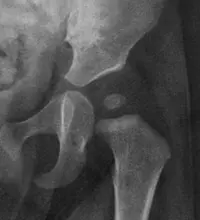Hip Dysplasia is a comprehensive term that has been used to include a spectrum of related developmental hip problems in infants and children, often present at birth. In hip dysplasia, the acetabulum (hip socket) may be abnormal in development or the femoral head (ball) may not be stable in the acetabulum. There are a few different ways of describing the condition of the hip:
|
Normal – the hip socket is deep and the ball is securely in the socket and cannot be pushed out of place. |
 |
|
Dysplastic – the hip socket is not deep but the ball is stable in the socket and cannot be pushed out of place. |
 |
|
Dislocated or dislocatable - the hip socket is not deep and the ball is either sitting outside the socket (dislocated) or it is easily pushed out of the socket (dislocatable). |
 |
What causes hip dysplasia?
Most hip dysplasia is of an unknown cause; however, it can be related to family history and position in the womb. If someone in the family has hip dysplasia, there is an increased risk that the child will have hip dysplasia. Most children born with hip dysplasia, however, do not have a positive family history. Breech position of the baby in the womb is also a risk factor for hip dysplasia. Hip dysplasia is more common in girls and in first born babies.
Is this a problem?
It can be. If left untreated, the hip may not develop properly over time and cause pain, early arthritis, and degenerative changes in the hip. In instances where the dysplasia is mild, it may resolve on its own and not need treatment. It is difficult to predict this and it is likely your doctor will recommend treatment.
What are the treatment options?
If the hip dysplasia is found at birth or shortly thereafter, the treatment is either a pavlik harness or hip abduction brace. Both devices hold the hip in an optimal position to allow the hip socket to develop around the ball and deepen as well as securing the joint itself, keeping the ball located in the socket. The success rate with the harness or brace is 95%; however, 5% of patients will need further treatment such as surgery to keep the ball in the socket or to deepen the socket. Your doctor will tell you if and when further treatment is needed for your child.
Back




Leave a Comment